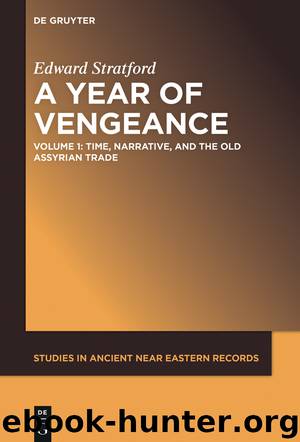A Year of Vengeance by Edward Stratford

Author:Edward Stratford
Language: eng
Format: epub
Publisher: Walter de Gruyter
Published: 2017-05-25T16:00:00+00:00
Chapter 18
The Volume of Trade
The reconstruction of the year of vengeance began with Ilabrat-bāni misappropriating 6⅓ minas of Šalim-aḫum’s tin. This was not a significant amount in relation to the total amount of tin that Šalim-aḫum was shipping to Anatolia at the time. Ilabrat-bāni likely sensed this, thinking the 6⅓ minas compared favorably with other typical costs on the road. His gross violation of shipping protocols aside, Ilabrat-bāni’s reasoning was not too far off-base. But the tin Ilabrat-bāni took, and the greater amount that Šalim-aḫum took back, existed in the context of an Assyrian volume of trade. If a close analysis of Šalim-aḫum’s activities provide a meaningful shift in consideration of the tempos of trade in the Assyrian trans-Taurus trade, then by the same token, a tally of his commercial activities has implications for a closely-related phenomena: the volume of goods that passed through the Assyrian trade each year. Earlier estimates are grossly outdated, and, however judicious they may have been regarding the basic numbers found in the documents, they are blunted by their lack of any real temporal dimension.
Analyzing Šalim-aḫum’s trade volume during the year of vengeance, along with evidence of other merchants’ volumes, provides a new framework on which to extrapolate the scale of the Old Assyrian trade. But it must be kept in mind that the year of vengeance was certainly not a year where the merchants (who lived through it) felt like they were doing the kind of volume to which they were accustomed. Šalim-aḫum’s letters reveal he was certainly afraid of low revenues. Nor is the present review able to produce a comprehensive characterization of Old Assyrian trade volume. Here, only one metric will be attempted. Some Assyrians generated profit within Anatolia, but most of their capital (as best we can tell) arose from the chief ‘exports’ of Assur: tin and textiles.825 Šalim-aḫum specialized in exporting tin and textiles, making a survey of his commercial volume in the year of vengeance directly applicable.
Rather than proposing independent volumes of tin and textiles, I will instead focus on the donkey-load. There were periods when the colony demanded an equal number of donkeys in a caravan carrying tin and textiles from the home city. For the Assyrian treaties with cities on the route, the focus was often on the donkey-load.826 And because the present analysis will primarily yield a sense of scale as opposed to a real estimate, donkey-loads will be a useful metric. Donkeys bore not only individual loads of tin or textiles on their journeys, but in some sense the weight of the entire trade. So in honor of all the donkeys fallen in the pursuit of Assyrian profit, Old Assyrian exports will be expressed in terms of donkey-loads, split evenly, albeit over-simply, between tin and textiles. A conservative estimate of 5000 donkey-loads exported annually better signals the scale of trade than previous, much smaller, estimates. If this were equally divided, it would yield 62,500 textiles and 200 tons of tin. While this tin figure seems
Download
This site does not store any files on its server. We only index and link to content provided by other sites. Please contact the content providers to delete copyright contents if any and email us, we'll remove relevant links or contents immediately.
| Africa | Americas |
| Arctic & Antarctica | Asia |
| Australia & Oceania | Europe |
| Middle East | Russia |
| United States | World |
| Ancient Civilizations | Military |
| Historical Study & Educational Resources |
Empire of the Sikhs by Patwant Singh(23020)
The Wind in My Hair by Masih Alinejad(5056)
Rise and Kill First by Ronen Bergman(4739)
The Templars by Dan Jones(4656)
The Rape of Nanking by Iris Chang(4165)
12 Strong by Doug Stanton(3525)
Blood and Sand by Alex Von Tunzelmann(3164)
Babylon's Ark by Lawrence Anthony(2648)
The History of Jihad: From Muhammad to ISIS by Spencer Robert(2599)
No Room for Small Dreams by Shimon Peres(2343)
The Turkish Psychedelic Explosion by Daniel Spicer(2330)
Inside the Middle East by Avi Melamed(2325)
Gideon's Spies: The Secret History of the Mossad by Gordon Thomas(2319)
Arabs by Eugene Rogan(2279)
The First Muslim The Story of Muhammad by Lesley Hazleton(2245)
Come, Tell Me How You Live by Mallowan Agatha Christie(2228)
Bus on Jaffa Road by Mike Kelly(2123)
Kabul 1841-42: Battle Story by Edmund Yorke(2003)
1453 by Roger Crowley(1994)
